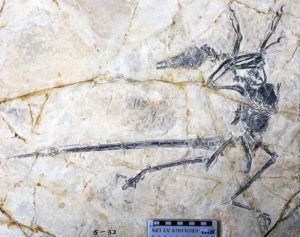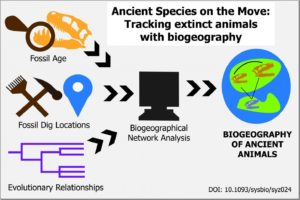by M. Benton, Sep 25, 2020 in ScienceAlert
Huge volcanic eruptions 233 million years ago pumped carbon dioxide, methane, and water vapour into the atmosphere. This series of violent explosions, on what we now know as the west coast of Canada, led to massive global warming.
Our new research has revealed that this was a planet-changing mass extinction event that killed off many of the dominant tetrapods and heralded the dawn of the dinosaurs.
The best known mass extinction happened at the end of the Cretaceous period, 66 million years ago. This is when dinosaurs, pterosaurs, marine reptiles and ammonites all died out.
This event was caused primarily by the impact of a giant asteroid that blacked out the light of the sun and caused darkness and freezing, followed by other massive perturbations of the oceans and atmosphere.
Geologists and palaeontologists agree on a roster of five such events, of which the end-Cretaceous mass extinction was the last. So our new discovery of a previously unknown mass extinction might seem unexpected.
And yet this event, termed the Carnian Pluvial Episode (CPE), seems to have killed as many species as the giant asteroid did. Ecosystems on land and sea were profoundly changed, as the planet got warmer and drier.
On land, this triggered profound changes in plants and herbivores. In turn, with the decline of the dominant plant-eating tetrapods, such as rhynchosaurs and dicynodonts, the dinosaurs were given their chance.

…
by Michael Gresko, July 11, 2019 in NationalGeographic
…
The find—described today in the journal Current Biology—is the fourth Microraptor fossil to preserve stomach contents, but it’s the first to show that Microraptor ate lizards. Previous fossils captured it eating small mammals, fish, or birds. The specimen also reveals that, like some predatory birds today, Microraptor had a taste for swallowing lizards whole and head-first.
…

This fossil of the feathered dinosaur Microraptor also preserves the animal’s last meal: a lizard it seems to have swallowed whole and head first.
PHOTOGRAPH BY XUWEI YIN
by Charles the moderator, May 31, 2019 in WUWT
University of Tokyo
One researcher at the University of Tokyo is in hot pursuit of dinosaurs, tracking extinct species around ancient Earth. Identifying the movements of extinct species from millions of years ago can provide insights into ancient migration routes, interaction between species, and the movement of continents.
“If we find fossils on different continents from closely related species, then we can guess that at some point there must have been a connection between those continents,” said Tai Kubo, Ph.D., a postdoctoral researcher affiliated with the University Museum at the University of Tokyo.
A map of life – biogeography
Previous studies in biogeography — the geographic distribution of plants and animals — had not considered the evolutionary relationships between ancient species. The new method that Kubo designed, called biogeographical network analysis, converts evolutionary relationships into geographical relationships.
…

By combining data from fossils and models of the ancient Earth, researchers can map where ancient species may have migrated. This method, called biogeographical network analysis, converts evolutionary relationships between species into geographical relationships. This method was used in research by Tai Kubo, Ph.D., a postdoctoral researcher affiliated with the University Museum at the University of Tokyo. Credit Caitlin Devor, The University of Tokyo, CC-BY Usage Restrictions Image by Caitlin Devor, The University of Tokyo, CC-BY
by Douglas Preston, April 8, 2019 in TheNewYorker
…
One of the central mysteries of paleontology is the so-called “three-metre problem.” In a century and a half of assiduous searching, almost no dinosaur remains have been found in the layers three metres, or about nine feet, below the KT boundary, a depth representing many thousands of years. Consequently, numerous paleontologists have argued that the dinosaurs were on the way to extinction long before the asteroid struck, owing perhaps to the volcanic eruptions and climate change. Other scientists have countered that the three-metre problem merely reflects how hard it is to find fossils. Sooner or later, they’ve contended, a scientist will discover dinosaurs much closer to the moment of destruction.
…
Locked in the KT boundary are the answers to our questions about one of the most significant events in the history of life on the planet. If one looks at the Earth as a kind of living organism, as many biologists do, you could say that it was shot by a bullet and almost died. Deciphering what happened on the day of destruction is crucial not only to solving the three-metre problem but also to explaining our own genesis as a species.
by U. of California – Berkeley, March 29, 2019 in ScienceDaily
-
Paleontologists have found a fossil site in North Dakota that contains animals and plants killed and buried within an hour of the meteor impact that killed the dinosaurs 66 million years ago. This is the richest K-T boundary site ever found, incorporating insects, fish, mammals, dinosaurs and plants living at the end of the Cretaceous, mixed with tektites and rock created and scattered by the impact. The find shows that dinosaurs survived until the impact.
…
by Univ. of California – Berkeley, February 21, 2019 in ScienceDaily
Based on new data published today in the journal Science, it seems increasingly likely that an asteroid or comet impact 66 million years ago reignited massive volcanic eruptions in India, half a world away from the impact site in the Caribbean Sea.
But it leaves unclear to what degree the two catastrophes contributed to the near-simultaneous mass extinction that killed off the dinosaurs and many other forms of life.
The research sheds light on huge lava flows that have erupted periodically over Earth’s history, and how they have affected the atmosphere and altered the course of life on the planet.
…
La géologie, une science plus que passionnante … et diverse



